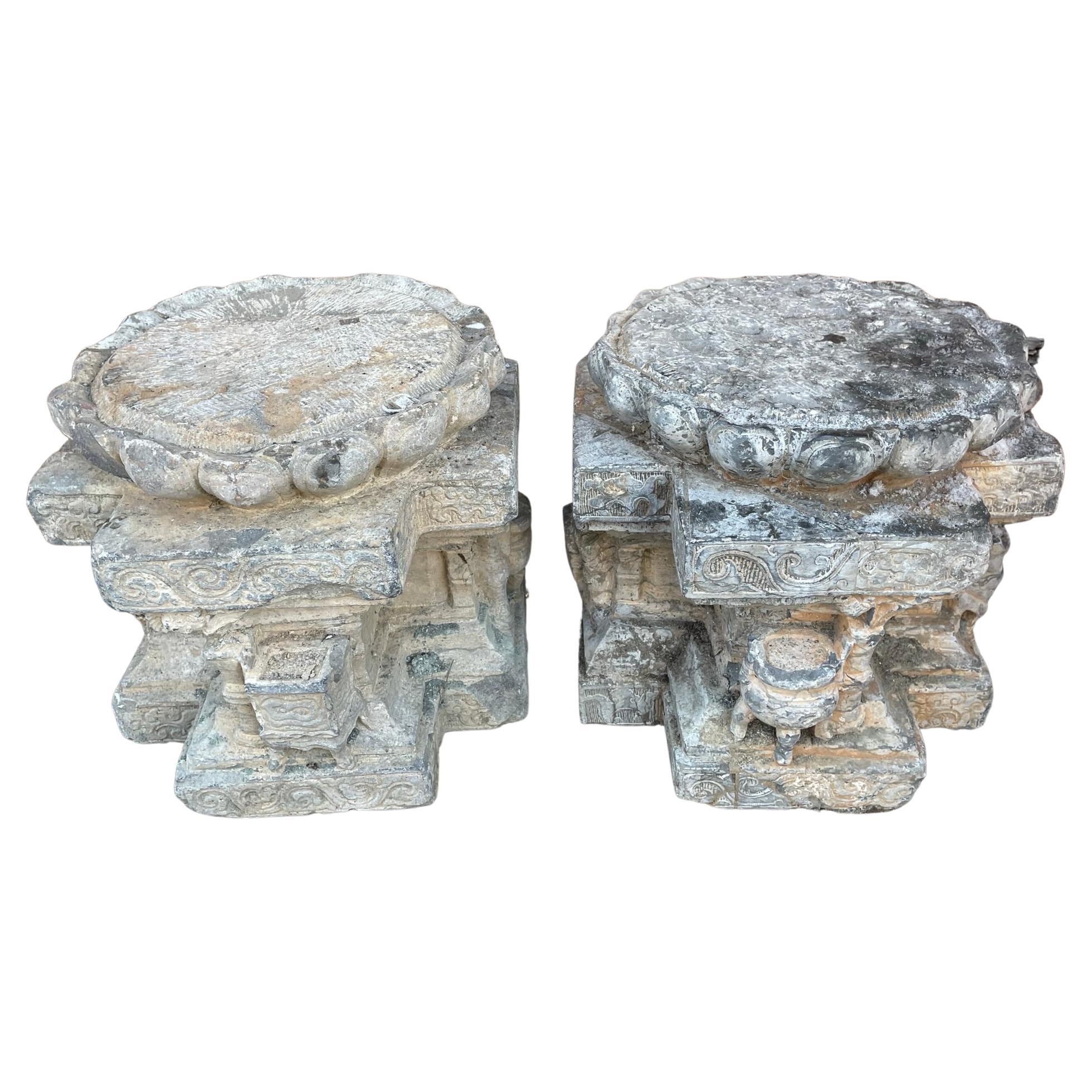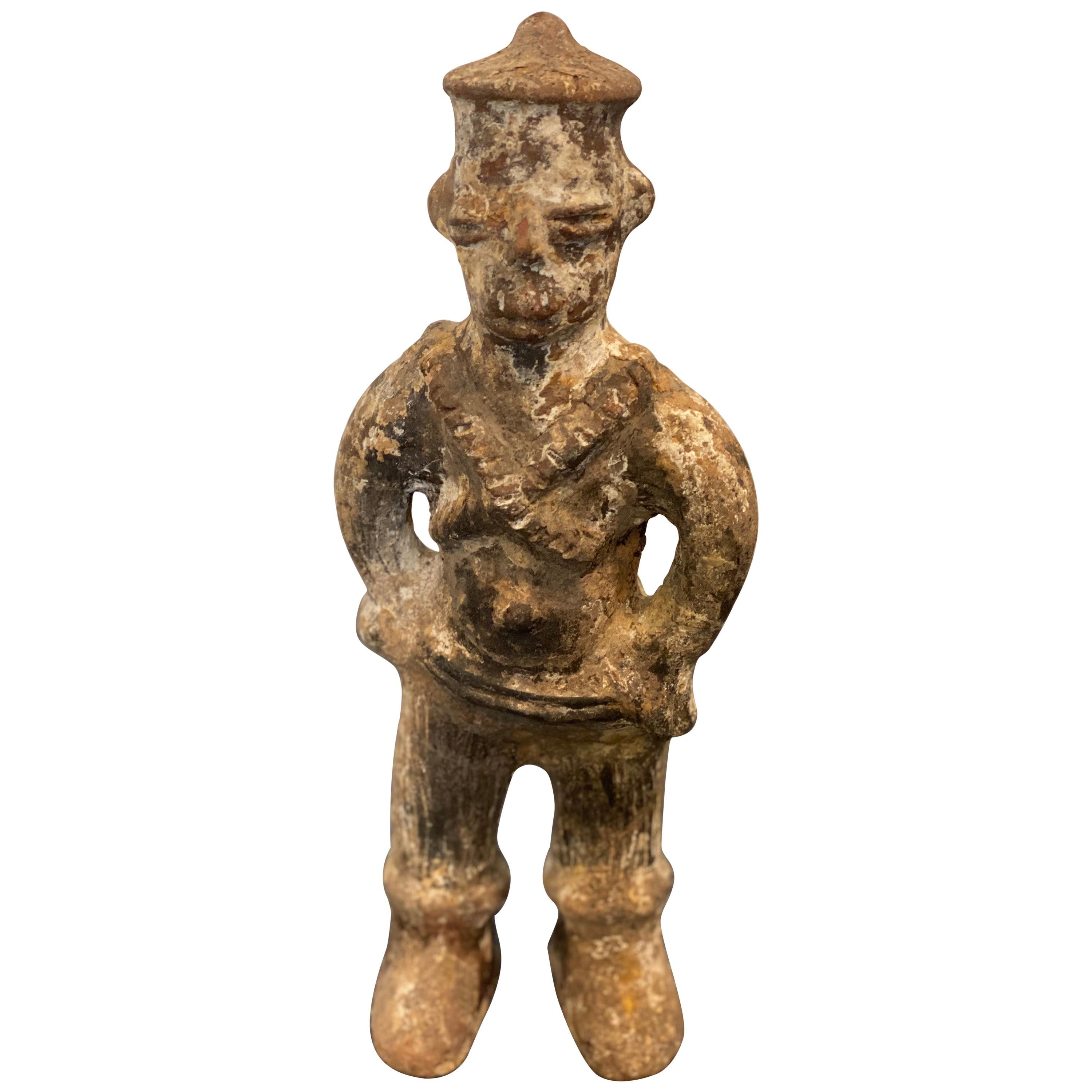Items Similar to Pair of 19th Century Chinese Carved Stone Lions
Want more images or videos?
Request additional images or videos from the seller
1 of 14
Pair of 19th Century Chinese Carved Stone Lions
About the Item
An unusual pair of Chinese carved Stone models of lions, each depicted with opposing heads and seated on lotus bases. In good condition and retaining a nicely weathered surface. Circa 1880.
H: 49 cm (19 5/16")
W: 30 cm (11 13/16")
D: 21 cm (8 1/4")
- Dimensions:Height: 19.3 in (49 cm)Width: 11.82 in (30 cm)Depth: 8.27 in (21 cm)
- Style:Qing (Of the Period)
- Materials and Techniques:
- Place of Origin:
- Period:
- Date of Manufacture:Circa 1880
- Condition:
- Seller Location:Shipston-On-Stour, GB
- Reference Number:1stDibs: LU8978239325012
About the Seller
No Reviews Yet
Vetted Seller
These experienced sellers undergo a comprehensive evaluation by our team of in-house experts.
1stDibs seller since 2023
Typical response time: 1 hour
- ShippingRetrieving quote...Ships From: Shipston-On-Stour, United Kingdom
- Return PolicyThis item cannot be returned.
More From This SellerView All
- Large early 19th Century Khmer Terracotta FigureLocated in Shipston-On-Stour, GBA very rare larger than life size late C18th/early C19th terracotta figure of a male diety, in the Khmer style, the figure sitting in a relaxed pose, with hair tied up and a serene c...Category
Antique Early 19th Century Cambodian Tibetan Sculptures and Carvings
MaterialsTerracotta
- Pair of 19th Century Gouches of NaplesLocated in Shipston-On-Stour, GBAn early C19th pair of finely detailed gouaches, depicting unusual scenes of the bays of Naples and Sorrento. In charming light colours and excellent condition. Circa 1820. H: 45 cm...Category
Antique 1820s Italian Grand Tour Paintings
MaterialsPaint
- 19th Century Chinese Reverse Glass PaintingLocated in Shipston-On-Stour, GBA good quality C19th Chinese reverse painting on glass of large size, brightly coloured with depicting dignitaries, ladies and attendants in a courtyar...Category
Antique 1880s Chinese Chinese Export Paintings and Screens
MaterialsGlass
- 19th Century Chinese Reverse Glass PaintingLocated in Shipston-On-Stour, GB19th century unusual Chinese reverse painting on glass, depicting a busy Hong Kong harbour scene with trade boat flying different countries flags, loca...Category
Antique 1880s Chinese Chinese Export Paintings and Screens
MaterialsGlass, Wood, Paint
- 19th Century Carved Bear Hall StandLocated in Shipston-On-Stour, GBAn impressive late 19 century Black Forest carved bear hall stand, of a bear looking up while holding a tree with three branches forming coat/hat hooks, with an inquisitive bear cub ...Category
Antique 1880s Swiss Black Forest Coat Racks and Stands
MaterialsWood
- Lifesize 19th Century Quirky Carved Wood AntelopeLocated in Shipston-On-Stour, GB A unusual late 19th Century wood carved antelope, with naive expression on his face and in a spread stance, finished in his original brightly coloured decoration. Circa 1880. H: 9...Category
Antique 1880s Indian Country Animal Sculptures
MaterialsWood, Paint
You May Also Like
- China Pair Antique Hand Carved Stone Pedestals 19th CenturyLocated in South Burlington, VTHard to Find Pair from the 19th Century From China's Qing dynasty (1644-1912) a hard to find pair (2) of limestone finely carved pedestals - perfect for displaying your indoor or o...Category
Antique 19th Century Chinese Qing Sculptures and Carvings
MaterialsStone, Limestone
- Chinese Qing Dynasty 19th Century Carved Stone Foo Dog Guardian Lion SculptureLocated in Yonkers, NYA Chinese Qing Dynasty period carved stone foo dog guardian lion from the 19th century, on square base. Created in China during the Qing Dynasty, this st...Category
Antique 19th Century Chinese Qing Statues
MaterialsStone
- Pair of 19th Century Chinese Stone Fu DogsLocated in Chicago, ILThis pair of 19th century carved limestone Fu dogs with sinister smiles and furled brows once guarded the entrance to one of provincial China's grand homes. One peers up and the othe...Category
Antique Mid-19th Century Chinese Qing Sculptures and Carvings
MaterialsLimestone
- 19th Century Chinese Carved FigureLocated in Southampton, NY19th century Chinese carved figure. While this sculpture may be small it isn't lacking in its attention to detail. Across the chest of the figure you cans see two overlapping carved...Category
Antique 19th Century Chinese Qing Sculptures and Carvings
MaterialsWood
- Chinese Green Glazed Foo Lions, Near Pair, Late 19th Century, ChinaLocated in Austin, TXA charming near pair of Chinese green glazed foo lion joss stick holders, late 19th century, China. The delightful foo lions, also referred to as foo dogs, crafted as joss (incens...Category
Antique Late 19th Century Chinese Qing Sculptures and Carvings
MaterialsStoneware
- A pair of 19th Century carved Foo temple dogs or Chinese guardian LionsLocated in London, GBChinese guardian lions, or imperial guardian lions, are a traditional Chinese architectural ornament. Typically made of stone, they are also known as stone lions or shishi (石獅; shíshī). They are known in colloquial English as lion dogs or foo dogs / fu dogs. The concept, which originated and became popular in Chinese Buddhism, features a pair of highly stylized lions—often one male with a ball and one female with a cub—which were thought to protect the building from harmful spiritual influences and harmful people that might be a threat. Used in imperial Chinese palaces and tombs, the lions subsequently spread to other parts of Asia including Japan (see komainu), Korea, Philippines, Tibet, Thailand, Myanmar, Vietnam, Sri Lanka, Nepal, Cambodia, Laos, and Malaysia. There has been extensive interaction between Chinese mythology and Confucianism, Taoism, and Buddhism. Elements of pre-Han dynasty mythology such as those in Classic of Mountains and Seas were adapted into these belief systems as they developed (in the case of Taoism), or were assimilated into Chinese culture (in the case of Buddhism). Elements from the teachings and beliefs of these systems became incorporated into Chinese mythology. For example, the Taoist belief of a spiritual Paradise became incorporated into mythology as the place where immortals and deities used to dwell. Sometimes mythological and religious ideas have become widespread across China's many regions and diverse ethnic societies. In other cases, beliefs are more limited to certain social groups, for example, the veneration of white stones by the Qiang. One mythological theme that has a long history and many variations involves a shamanic world view, for example in the cases of Mongolian shamanism among the Mongols, Hmong shamanism among the Miao people, and the shamanic beliefs of the Qing dynasty from 1643 to 1912, derived from the Manchus. Politically, mythology was often used to legitimize the dynasties of China, with the founding house of a dynasty claiming a divine descent. Mythology and philosophy. Further information: Chinese philosophy True mythology is distinguished from philosophical treatises and theories. Elaborations on the Wu Xing are not really part of mythology, although belief in five elements could appear. The Hundred Schools of Thought is a phrase suggesting the diversity of philosophical thought that developed during the Warring States of China. Then, and subsequently, philosophical movements had a complicated relationship with mythology. However, as far as they influence or are influenced by mythology, divides the philosophical camps into two rough halves, a Liberal group and a Conservative group. The liberal group being associated with the idea of individuality and change, for example as seen in the mythology of divination in China, such as the mythology of the dragon horse that delivered the eight bagua diagrams to Fu Xi, and methods of individual empowerment as seen in the Yi Jing (Book of Changes). The Liberal tendency is towards individual freedom, Daoism, and Nature. The relationship of the Conservative philosophies to mythology is seen in the legendary Nine Tripod Cauldrons, mythology about the emperors and central bureaucratic governance, Confucianism, written histories, ceremonial observances, subordination of the individual to the social groups of family and state, and a fixation on stability and enduring institutions. The distinction between the Liberal and Conservative is very general, but important in Chinese thought. Contradictions can be found in the details, however these are often traditional, such as the embrace by Confucius of the philosophical aspects of the Yi Jing, and the back-and-forth about the Mandate of Heaven wherein one dynasty ends and another begins based according to accounts (some of heavily mythological) where the Way of Heaven results in change, but then a new ethical stable dynasty becomes established. Examples of this include the stories of Yi Yin, Tang of Shang and Jie of Xia or the similar fantastic stories around Duke of Zhou and King Zhou of Shang. Mythology exists in relationship with other aspects of society and culture, such as ritual. Various rituals are explained by mythology. For example, the ritual burning of mortuary banknotes (Hell Money), lighting fireworks, and so on. A good example of the relationship of Chinese mythology and ritual is the Yubu, also known as the Steps or Paces of Yu. During the course of his activities in controlling the Great Flood, Yu was supposed to have so fatigued himself that he lost all the hair from his legs and developed a serious limp. Daoist practitioners sometimes incorporate a curiously choreographed pedal locomotion into various rituals. Mythology and practice, one explains the other: in these rituals, the sacred time of Yu merges with the sacral practice of the present. Various ideas about the nature of the earth, the universe, and their relationship to each other have historically existed as either a background or a focus of mythologies. One typical view is of a square earth separated from a round sky by sky pillars (mountains, trees, or undefined). Above the sky is the realm of Heaven, often viewed of as a vast area, with many inhabitants. Often the heavenly inhabitants are thought to be of an "as above so below" nature, their lives and social arrangements being parallel to those on earth, with a hierarchical government run by a supreme emperor, many palaces and lesser dwellings, a vast bureaucracy of many functions, clerks, guards, and servants. Below was a vast under ground land, also known as Diyu, Yellow Springs, Hell, and other terms. As time progressed, the idea of an underground land in which the souls of the departed were punished for their misdeeds during life became explicit, related to developments in Daoism and Buddhism. The underground world also came to be conceived of as inhabited by a vast bureaucracy, with kings, judges, torturers, conductors of souls, minor bureaucrats, recording secretaries, similar to the structure of society in the Middle Kingdom (earthly China). Chinese temple Dogs...Category
Antique 1860s Chinese Chinese Export Sculptures and Carvings
MaterialsHardwood
Recently Viewed
View AllMore Ways To Browse
Lapis Snuff Bottle
Budai Statue
Balinese Wooden Bust
Vintage Japanese Hand Painted Eggs 10
Temple Artifacts
Chinese Buddha Carving
Chinese Hand Carved Wooden Sculptures And Carvings
Buddhist Stupa
Wall Hanging With Dragon
Antique Large Wooden Figurines
Chinese Art Metal
Large Tall Basket
Pesce Gaetano Glass
Pair Green Glass Sconces
Traditional Tribal Hand Knotted Wool Gray Area Rug
Charlotte Perriand Low Table
Coffee Table With Raised Edge
French Mid Century Desk Accessories





